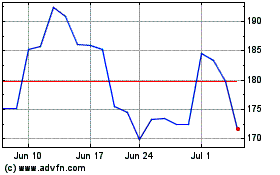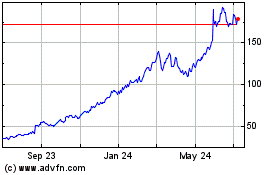CORRECT: Retailers Report Mixed Results For May Same-Store Sales
June 03 2010 - 3:24PM
Dow Jones News
Retailers turned in mixed results for May, providing further
indications of a choppy recovery in consumer spending.
Sales were generally slow early in the month but did show signs
of picking up as it progressed, although some discretionary items
had a hard time finding buyers. Teen apparel retailers --
considered a good proxy for discretionary spending -- generally had
a tough time. Department stores that have been struggling during
the economic downturn ended up turning in a flat performance.
Discounters, which have a track record of faring well in tough
economies, did well.
Conditions are tenuous, said Chris Donnelly, partner in the
retail practice of Accenture. "Consumers are still so budget
conscious, but they also have real needs at this point."
The situation may mean that people are shifting their spending a
bit. "People haven't really been buying a lot of new clothing and
now that it's wearing out, they may shift their dollars to this
category and away from something like consumer electronics or
dining out," Donnelly said. "It's still a matter of limited dollars
to go around."
Retailers in general were able to show growth in sales at stores
open for more than a year, but their gains were modest. The erratic
results follow a strong holiday season and start to the year, when
consumers showed a willingness to spend again and even pay closer
to full price.
The results validate the posture many retailers adopted last
month when reporting first-quarter results. While many reported
strong growth, companies restrained from being overly optimistic
for the full year.
Also affecting May sales was a calendar shift that put Memorial
Day weekend into the June reporting period for many retailers. For
example, Macy's Inc. (M) said its same-store sales in May would
have been up by about 5% if not for the later Memorial Day.
Instead, the company reported same-store sales growth of 1.4%,
above the Thomson Reuters estimate of 0.9%.
"Our business trend strengthened toward the end of the month as
the weather turned warmer and we approached Memorial Day," Chief
Executive Terry Lundgren said.
Target Corp. (TGT) said its same-store sales rose 1.3%, a
whisker ahead of expectations for a 1.2% advance. The retailer
expects a new credit-card rewards program to help drive better
same-store sales.
But Target, like other retailers, said it sees continued
volatility in the pace of the recovery.
Costco Wholesale Corp. (COST) saw continued weak television
sales and softness in its international business, but its results
were strong across housewares, home furnishings, small appliances,
and jewelry. Costco reported a 9% increase in same-store sales,
which missed analysts' estimates for a 9.7% gain.
Wet Seal Inc. (WTSLA) posted a drop in sales, but not by as much
as analysts' projected. The apparel retailer said it remains
cautious about the second quarter but is hopeful that its June
results can benefit from buying that occurred over the latter part
of the Memorial Day weekend.
Results were mixed from teen retailers, with Zumiez Inc. (ZUMZ)
surpassing expectations and Buckle Inc. (BKE), Abercrombie &
Fitch Co. (ANF) and Hot Topic Inc. (HOTT) declining by a
wider-than-expected amount.
All told, the 28 retailers tracked by Thomson Reuters posted
same-store sales growth of 2.5% for May, when 2.6% was expected,
and after a 4.8% decline a year ago. This is the second time in a
row retailers missed expectations after a solid start to the year.
The showings in April and May were retailers' smallest monthly
same-store sales growth since November. Wal-Mart Stores Inc. (WMT),
the nation's biggest retailer, doesn't report monthly same-store
sales.
May results were expected to be erratic following April's soft
showing as retailers indicated that last month started off slowly.
In between, the stock market was pummeled over concerns about
Europe and the historic oil spill.
The see-saw showing so far in 2010 is a sign of consumers'
uncertainty as they deal with an unemployment rate near 10% and
other economic concerns. Even the recent strength in housing is
being attributed to federal tax credits that have now expired.
"People are acting like turtles," said Mike Berry, director of
industry research for MasterCard Advisors SpendingPulse. "And right
now they are pulling their heads back in."
Working in retailers' favor is that few appear to be engaging in
big markdowns that got them into so much trouble during the
recession. They are holding the line on prices as they better match
their inventory to demand.
"Something to keep an eye on is if retailers start using pricing
incentives to try and get customers back in stores," Berry
said.
The move would say a lot about how consumers are feeling going
forward. If consumers put the brakes on what buying they were
doing, retailers will be forced to ratchet down their own
expectations for the year.
Richard Galanti, chief financial officer at Costco, said last
week that customers "are buying more food and sundries and less
$1,000 TVs."
-By Karen Talley, Dow Jones Newswires; 212-416-2196;
karen.talley@dowjones.com
Abercrombie and Fitch (NYSE:ANF)
Historical Stock Chart
From May 2024 to Jun 2024

Abercrombie and Fitch (NYSE:ANF)
Historical Stock Chart
From Jun 2023 to Jun 2024
